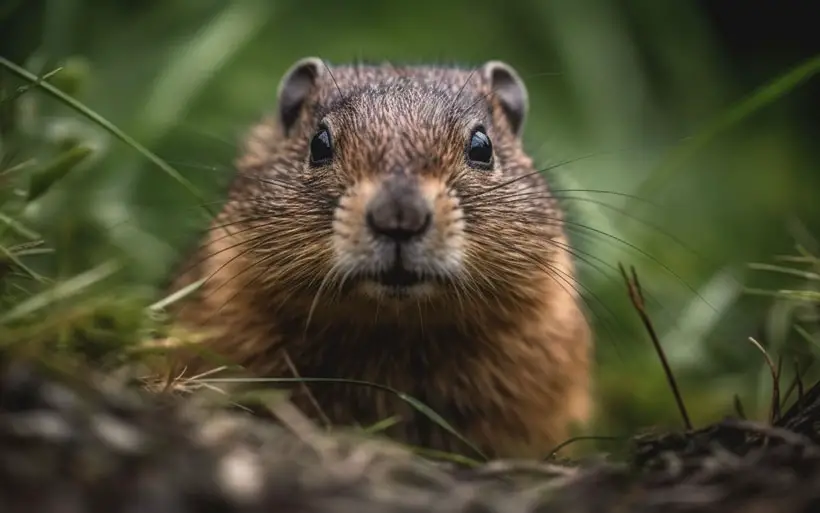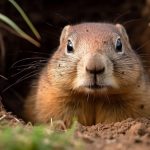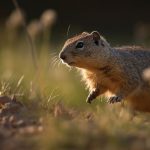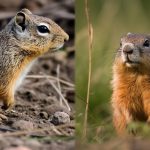Exploring Gopher Size: How Big Can a Gopher Get?
Gophers are small, burrowing rodents that play a significant role in various ecosystems throughout North and Central America. They are fascinating creatures that are well adapted to their underground lifestyle. They are known for their impressive digging abilities.
However, their burrowing behavior can also cause damage to crops, gardens, and other vegetation. These have made them backyard pests and made it essential to understand their size and behavior to manage their impact. By understanding the physical characteristics of gophers, including their size and weight, we can-
- Develop effective strategies for managing their populations and reducing their impact on human activities.
- In addition, understanding the size and animal behavior of gophers is crucial in protecting other wildlife. Especially those that may rely on them for food or habitat.
Moreover, it’s significant in protecting the ecosystems they inhabit. In this article, we will explore the question, “How big can a gopher get?” Moreover, we will discuss their physical characteristics and how these relate to their behavior and survival in the wild.
Gopher Size Variations
While gophers may seem similar in appearance, they vary in size, weight, and other physical characteristics. This section will discuss the different sizes of gophers, including variations among different species and within a single species.

Different Sizes of Gophers
Gophers can range in size from around 6 to 8 inches in body length on average and weigh around 200 grams on average. However, some species can reach up to 14 inches in length and 2.2 pounds in weight.
Generally, males are larger than females, but this varies among species. Gophers have small eyes and ears and short legs that are adapted for digging.
Variations in Size Among Different Species
There are approximately 41 different species of gophers. While they share similar physical characteristics, they vary in size. There are some examples of sizes for different gopher species.

- Plains Pocket Gopher: The Plains Pocket Gopher, found in the Great Plains of North America, is one of the largest species. They can grow up to 14 inches in length and weigh up to 1 pound.
- Wyoming Pocket Gopher: The Wyoming Pocket Gopher, found in California, is one of the smallest species. They grow up to only 6 inches in length and weigh up to 2.5 ounces.
In addition to size, gophers also vary in other physical characteristics, such as fur color and texture. Here are some examples of fur color and texture for different gopher species.
- Botta’s Pocket Gopher: This type of gopher has soft and silky fur.
- Northern Pocket Gopher: These gophers have soft, short, brown fur with faint underparts that range from brown to yellowish-brown.
Factors Contributing to Variations in Gopher Size
Gopher size can also vary within a single species. Several factors can contribute to these variations, including age, sex, and geographic location.
- Age: Young gophers are typically smaller than adults. As they grow older, they become larger and heavier.
- Sex: Male gophers are usually larger and heavier than females. This is because males need to be bigger to compete with other males for mates.
- Geographic location: Gophers that live in different regions can also vary in size. For instance, gophers that live in colder climates are typically larger than those that live in warmer areas. This is because larger gophers have a better chance of surviving in colder environments.
Factors that Influence Gopher Growth
Gophers’ growth and size are influenced by a variety of factors that interact with each other throughout their lifespan. Understanding these factors can help us better understand the biology and ecology of gophers.

Genetics
Genetics plays a significant role in gopher growth and size. Different gopher species have varying growth rates and maximum sizes.
Additionally, individual gophers within a species may have genetic variations that affect their growth. Genetic traits such as body size, bone density, and metabolic rate can all impact gopher growth.
Diet
Gophers are herbivores and primarily eat roots, tubers, and other underground plant parts. The quality and quantity of these food sources can have a direct impact on gopher growth.
Gophers that have access to a diverse range of high-quality food sources are more likely to grow faster and larger. However, this isn’t true for those with limited or poor-quality food options.
Habitat Quality
Gophers are adapted to live in a variety of habitats, from grasslands to forests. The quality of their habitat can significantly impact their growth and size. Gophers living in high-quality habitats with ample food, water, and shelter are more likely to grow larger and faster than in low-quality habitats.
Habitat quality can also affect other factors that influence gopher growth, such as predation risk and disease exposure.
- Predation risk: Gophers that live in habitats with less cover are more vulnerable to predation by predators such as hawks, owls, coyotes, and foxes. In contrast, gophers living in vegetation and burrowing sites may be less vulnerable to predation. It’s because there are more cover and hiding places.

This can significantly impact gopher growth and survival, as predators can significantly reduce population size and limit the availability of resources. Predation risk can hamper gopher growth by
- Reducing foraging time
- Allocating more energy to stress responses
- Causing behavioral changes
- Resulting in injury or mortality
- Disease exposure: Gophers living in habitats with poor sanitation, such as those with high levels of contamination or overcrowding, may be more susceptible to disease. This is because poor environmental conditions can weaken the immune system. This makes gophers more vulnerable to infections and diseases.
Conversely, gophers living in clean, well-maintained habitats are less likely to be exposed to pathogens. They may have stronger immune systems, leading to healthier individuals and populations.
Environmental Factors
Environmental factors, such as temperature and moisture levels, can also impact gopher growth. Gophers are adapted to live in a range of temperatures, but extreme heat or cold can stress their bodies and slow their growth.
Moisture levels are also important, as gophers need access to water to survive and grow. Drought conditions can limit food and water availability, which can negatively impact gopher growth.
Identifying Gopher Sizes
While all gophers share some basic physical characteristics, there are differences in size and appearance between species. It can happen even between individuals within a single species.

Physical Characteristics to Look For
When trying to identify the size of a gopher, there are several physical characteristics to look for. These include:
- Body length: Measure the length of the gopher’s body from the tip of its nose to the base of its tail.
- Tail length: Measure the length of the gopher’s tail, starting at the base of the tail where it meets the body.
- Weight: Use a small scale to weigh the gopher.
- Head size: Compare the size of the gopher’s head to its body.
How to Measure Gopher Sizes
You can follow the following process.
- To measure a gopher’s body length, gently hold the animal still.
- Use a ruler or measuring tape to measure from its nose to the base of its tail.
- To measure the length of its tail, use the same method to measure from the base of the tail to the tip.
- Be sure to handle the gopher gently and release it back into its burrow as quickly as possible.
Distinguishing Between Different Sizes Within a Species
Even within a single species of gopher, there can be variations in size. For example, pocket gophers can range in size from 5 to 14 inches in length and weigh anywhere from 0. 5 to 2.2 pounds.
To distinguish between different sizes within a species, it’s important to look at multiple physical characteristics, such as
- Body length
- Tail length
- Weight
Comparing these physical measurements to known averages for the species can also be helpful in distinguishing between different sizes.
Gopher Physical Characteristics

Following are the physical characteristics of gophers.
Fur
Gophers have thick fur coats that vary in color depending on the species and their habitat. The fur is usually brown or gray, which helps them blend into their environment. It’s also water-resistant.
Teeth
Gophers have large, sharp front teeth that are ideal for burrowing. Their teeth also continuously grow, which allows them to keep them sharp and in good condition.
If their teeth become too long, it can cause dental problems and interfere with their ability to eat and survive. Therefore, gophers must continually wear down their teeth through their natural activities to keep them at a functional length. This includes burrowing and gnawing.
Other Adaptations

Gophers have several other physical adaptations that help them survive in their habitat. For example:
- Claws: Gophers have strong claws on their front feet.
- Ears: They have small ears that are close to their head. This helps protect them from dirt and debris while burrowing.
- Eyes: Gophers have small eyes that are positioned on the sides of their head. This gives them a wide field of vision and allows them to detect predators from different directions.
- Body shape: Gophers have a compact, cylindrical body shape that is ideal for burrowing through soil.
Relation to Burrowing Behavior and Survival
The physical characteristics of gophers are directly related to their burrowing behavior and survival in their habitat. For example:
- Fur: The water-resistant fur of gophers allows them to burrow through wet soil without getting wet or cold. This helps them survive in areas with high rainfall.
- Teeth: Gophers’ sharp teeth allow them to burrow through tough soil and roots. This helps them find food and create safe burrows to live in.
- Claws: The strong claws of gophers allow them to dig quickly and efficiently. This helps them create extensive burrow systems and escape from predators.
FAQs
Let’s look at some additional related questions and their answers about gophers.
Q. How long do gophers typically live?
Ans. Gophers typically live for around 1-3 years in the wild, although some may live longer in captivity. Their lifespan can be affected by a variety of factors, such as predation, disease, and habitat quality. Some species of gophers may also have slightly longer or shorter lifespans than others.
Q. Can gophers continue to grow throughout their entire life?
Ans. Gophers, like all rodents, have teeth that grow continuously throughout their lifetime. This allows them to maintain their sharpness for burrowing and gnawing on tough plant material.
However, their bodies do not continue to grow indefinitely, and they reach their adult size within a few months after birth. The rate of tooth growth varies among different species of gophers.
Conclusion
In conclusion, the question of how big gophers can get is necessary to be answered for several reasons. Firstly, the importance of understanding gopher growth and physical characteristics is great for wildlife management. Secondly, pest control companies also find it highly beneficial.
Gophers can vary in size depending on their species, with some species growing larger than others. Their physical characteristics, such as their teeth and fur, play a vital role in their burrowing behavior and survival in their habitat.
Effective pest prevention strategies require an understanding of gopher behavior and physical characteristics. This can help reduce their impact on crops and gardens.
Moreover, their behavior and habitat preferences should also be studied. If you are having trouble with gophers, then you can take help from a wildlife removal service to trap and release them. However, keep in mind that trapping regulations vary by state.
In summary, understanding the size and physical characteristics of gophers is essential for managing their populations. It will be handy in reducing their impact on their environment. Further research in this area can help us better understand these fascinating creatures. It will develop more effective strategies for protecting the ecosystems they inhabit.




